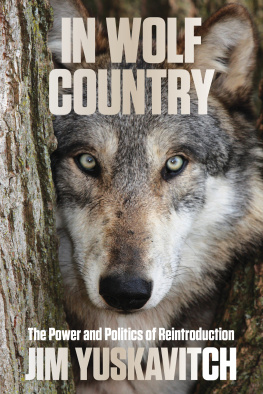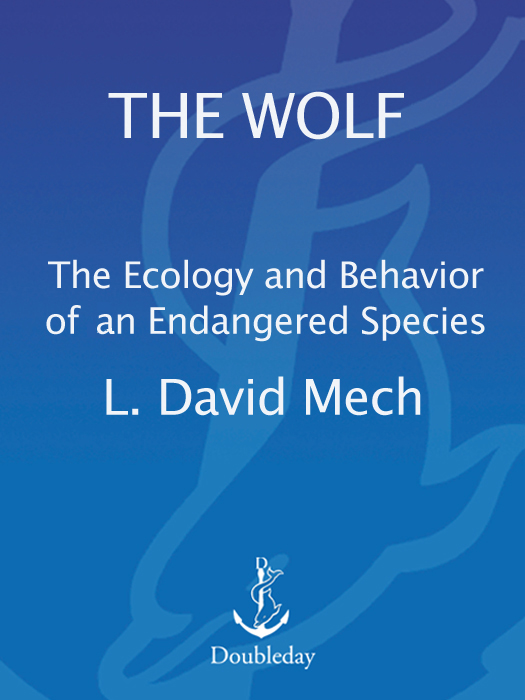Of all of the native biological constituents of a northern wilderness scene, I should say that the wolves present the greatest test of human wisdom and good intentions.
Paul L. Errington, 1967, Of Predation and Life
The Natural History Press, publisher for the American Museum of Natural History, is a division of Doubleday and Company, Inc. Directed by a joint editorial board made up of members of the staff of both the Museum and Doubleday, the Natural History Press publishes books and periodicals in all branches of the life and earth sciences, including anthropology and astronomy. The Natural History Press has its editorial offices at the American Museum of Natural History, Central Park West at Seventy-ninth Street, New York, New York 10024, and its business offices at 501 Franklin Avenue, Garden City, New York 11530.
The line illustrations for this book were prepared by the Graphic Arts Division of the American Museum of Natural History
Library of Congress Catalog Card Number 73100043
Copyright 1970 by L. David Mech
ALL RIGHTS RESERVED
eISBN: 978-0-307-81913-0
v3.1
This book is dedicated to Adolph Murie, who in the early 1940s became the first biologist to conduct an intensive and objective ecological study of the wolf.
CONTENTS

LIST OF TABLES

Weights of wolves
Percentages of observations of wolves in groups of various sizes
Percentages of wolves seen in groups of various sizes
Wolf sex ratios
Pup-adult ratios of wolves
Apparent survival rates of wolves
Distribution by age class of the total mortality occurring in wolves under natural control
Size of Isle Royale wolf population
Reported densities of wolf populations
Variations in howling characteristics of individual wolves
Mate preferences shown by members of a captive wolf pack
Breeding seasons of wolves at various latitudes
Average litter sizes reported for wolves
Weights of skinned wolf pups from Alaska
Development of captive wolf pups
Tooth development and replacement in a captive female wolf
Summary of the developments in the growth and living habits of wolf pups
Sizes of home ranges of wolf packs in winter
Principal foods of wolves in five areas of North America
Relative kill of various wolf prey in Alberta
Age distribution of Dall sheep mortality, Mount McKinley
Age distribution of moose killed by wolves on Isle Royale
Comparison of age distributions of wolf-killed deer and of general deer population in Algonquin Park, Ontario
Success rates of deer hunters in various regions of Minnesota
Flukes (Trematoda) of wolves
Tapeworm (Cestoda) parasites of wolves
Roundworm (Nematoda) parasites of wolves
External parasites of wolves
Pathological conditions reported for the wolf
LIST OF ILLUSTRATIONS

Map of North America.
Hair pattern and arrangement in members of the dog family.
Hair slope patterns in members of the dog family.
Evolution of the wolf.
The red wolf of southeastern and south-central United States.
The wolf.
The orbital angle.
Original distribution of subspecies of the wolf (Canis lupus) in North America.
Original distribution of subspecies of the wolf (Canis lupus) in Eurasia.
Present distribution and status of the wolf in North America.
Wolf pack in Isle Royale National Park.
A subordinate wolf shows passive submission.
Facial expressions of the wolf.
Expressive positions of the wolfs tail.
Presentation and withdrawal of the anal parts.
A subordinate wolf shows active submission.
Dominant wolves sometimes display their rank by ambushing subordinate ones.
A group ceremony.
The typical wolf greeting.
A wolf howl.
Chorus howling by pack members.
Apparent territoriality shown by wolf packs on Isle Royale in 1966.
Mating.
A wolf den.
Comparative growth rates of male and female wolf pups.
A wolf pup about three weeks old.
Riding up.
Wolf pups may settle their status early in life.
Wolf pups beg food.
Wolf pups.
The six-month-old wolf pup.
Rendezvous sites.
Wolf pack crossing frozen lake.
A deep, narrow wolf trail.
Movement of a pack of ten wolves in Alaska.
Wolves occasionally feed on birds and other small fare.
Wolf-killed deer remains.
Wolf near moose skeleton.
The moose.
Results of interactions of wolves and moose.
Wolves chasing moose.
A moose stands its ground upon attack.
The deer.
In much of the far north, caribou or reindeer are the chief prey of the wolf.
A wolf chases a herd of caribou.
Dall sheep.
Elk.
The bison.
Large herds of bison.
Musk-oxen.
Age distributions of deer killed by wolves in Algonquin Park, Ontario, and deer killed by automobiles and for research in the same area.
A white wolf of the arctic feeds on the remains of a dead musk-ox.
Wolf-hunting from an aircraft.
A poisoned deer carcass, and a number of wolves killed with it.
FOREWORD

Throughout the continents of Eurasia and North America primitive man evolved in association with wolves. Wolves competed with him as a hunter and raided his flocks and herds. Through the cold of winter the wolf made music in the mysterious darkness and sometimes, in curiosity, sat just beyond the dwindling circle of firelight and watched, his night-conditioned eyes reflecting twin sparks of light as a brand flared.
Inevitably our folklore became rich in tales of this powerful, resourceful competitor. The pasturalist feared and hated the creature for the damage it did; the returning hunter embroidered his prowess with tales of dangers surmounted as the wolf pack crowded around in the darkness; children were coerced into behavior with wolf threats.
Somewhere in early history a young wolf was brought into the family circle of man and through the years became the source of the domestic dog and our most successful and useful experiment in domestication. Even from early times there were those who found the wolf not all bad, as the delightful legends of Romulus and Remus and Mowgli testify. Many people acquired their attitudes toward wolves as they acquired their religion, and it is no wonder that the animal is still a subject of strongly held views.
Europeans reached North America with attitudes already formed. The wilderness and its creatures pressed in upon their tiny settlements in constant threat, and all energies were devoted to destroying it and turning its inexhaustible resources to use. Over vast areas of the continent the wolf went down with the wilderness before the unprecedented effectiveness of our technological attack on the ecology of a continent. Today, however, there is a great tide of concern over the consequences of our assault on the wild lands and wild creatures of the continent, and more and more biologists are devoting their knowledge and energy to searching studies of the various threatened aspects of our land and its native biota.











